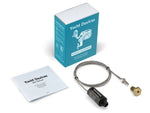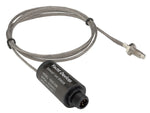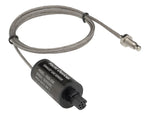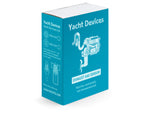The Sensor measure the temperature of extremely hot gases, solids and liquids within the range from 0 to +800 °C (+32 to 1472 °F).
The Exhaust Gas Sensor is designed not only for exhaust gas. With factory settings it transmits measured data as "Air Temperature" (because this data type is supported in all chart plotters), but can be reconfigured to display "Exhaust Gas Temperature", "Heating System Temperature", "Engine Room Temperature", etc.
The Device is plug and play; you only need to plug it into a NMEA 2000 backbone to get readings on all NMEA 2000 chart plotters and instruments onboard.
Picture 1. Exhaust Gas Sensor YDGS-01N
Temperature is measured by the thermocouple which is placed outside the Sensor case and has a flexible 90-cm (3 foot) sheath with an internal heat-resistant fiberglass insulation layer. The trade-off for such a wide temperature range is that the accuracy is
If you need better accuracy, we can recommend our Digital Thermometer YDTC-13, which has
The Sensor can be configured by user to turn on or off specified channels of digital switching equipment. For example, it can automatically turn on the ventilation or trigger an alarm when the temperature in the engine room is too high, and also turn it off when the temperature returns to normal (see Section VIII of the Manual for details).
The measurements of the last 48 hours are stored in the Device's RAM and can be retrieved by compatible software or hardware to provide the user with historical data.
![]() The Exhaust Gas Sensor, as all our sensors, supports firmware updates and three programming (configuration) methods. The simplest way is using a special installation description string which can be entered for the device in some modern models of chart plotters or in special software. Here you can see a video how to program and update the Sensor using CAN Log Viewer software.
The Exhaust Gas Sensor, as all our sensors, supports firmware updates and three programming (configuration) methods. The simplest way is using a special installation description string which can be entered for the device in some modern models of chart plotters or in special software. Here you can see a video how to program and update the Sensor using CAN Log Viewer software.
Support of the Exhaust Gas Sensor in other products:
- the NMEA 0183 Gateway and NMEA 2000 USB Gateway convert exhaust gas temperature to NMEA 0183 XDR sentence (looks like $YDXDR,C,22.0,C,EXHAUST*0B);
- the NMEA 2000 Wi-Fi Gateway also makes this conversion and can display these data in Web Gauges;
- the NMEA 0183 Wi-Fi Gateway and NMEA 0183 Wi-Fi Router can display these data in Web Gauges also;
- the Sensor can automatically manage loads connected to the Circuit Control YDCC-04;
- the Text Display with "Engine and Tank Monitoring" firmware displays exhaust gas temperature;
- the CAN Log Viewer can display historical graph from 10 sensors, update the Sensor's firmware, configure it and display live data from 3 sensors of "Exhaust Gas Temperature" type simultaneously;
- the PC software of Voyage Recorder supports four sensors of "Exhaust Gas Temperature" type.
The Exhaust Gas Sensor is designed for operation in an NMEA 2000 network and is compatible with a wide range of equipment supporting this protocol. Raymarine SeaTalk NG, Simrad SimNet, and Furuno CAN networks are branded versions of NMEA 2000 and differ only by connector type. Garmin uses the NMEA 2000 Micro connector in its devices, which is compatible with the DeviceNet Micro connector.
Picture 2. Drawing of YDGS-01N model of Device
The Device is supplied with SeaTalk NG and NMEA 2000 Micro Male connectors, making it possible to connect it to networks of different manufacturers without any adapters. The Device model is shown on the case.
For additional technical details, please see the User Guide and FAQ.









